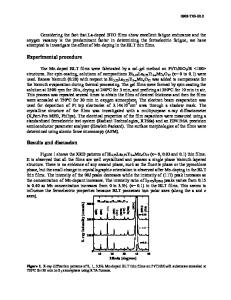Structural and Electro-Optic Properties of Laser-Ablated Ferroelectric Bi 4 Ti 3 O 12 Thin Films
- PDF / 284,576 Bytes
- 6 Pages / 420.48 x 639 pts Page_size
- 45 Downloads / 274 Views
STRUCTURAL AND ELECTRO-OPTIC PROPERTIES OF LASER-ABLATED FERROELECTRIC Bi4Ti3O12 THIN FILMS WILLIAM JO, HAG-JU CHO, TAE WON NOH, YUN SEOK CHO, AND SUK-IL KWUN Department of Physics, Seoul National University, 151-742, Seoul, Korea.
ABSTRACT Ferroelectric Bi4 Ti3O2 thin films have been deposited using second harmonics of a Q-switched Nd:YAG laser. Various single crystal substrates, including SrTiO 3(1(0O), SrTiO 3(1 10). MgO(100), and MgO(1 10), were used. Structural and electro-optic properties of the films were investigated using XRD, x-ray pole figure, and linear birefringence measurements. It is found that substrate kinds and their surface orientations are important growth parameters which determine crystal axis orientation and electro-optic properties of the Bi 4Ti3 02 thin films.
INTRODUCTION Thin films of ferroelectric materials are of much interest for fabricating novel functional devices. Ferroelectric thin films cannot only miniaturize devices and save source materials, but they can also increase the efficiency of operation of devices owing to their scale-reduction and configuration. Recently, laser ablation has emerged as a promising technique for stoichiometric growth of perovskite-type high temperature superconducting thin films. Efforts have also been made to apply this deposition technique to ferroelectric oxides[ 1-4]. Bismuth titanate, Bi4Ti3 OI2, is an interesting ferroelectric material with useful properties for non-volatile memory[5] and electro-optic devices[6]. Epitaxial Bi 4Ti3012 thin films have been successfully grown by pulsed laser deposition on SrTiO 3(100)[1,4], MgO(1 10)[2], and YBa 2Cu 3O7(001)[3]. The feasibility for growing lattice-matched heterostructures makes this material very attractive for several applications. In this paper, we report structural and electrooptic properties of laser-ablated Bi 4T 3 012 thin films grown on SrTiO 3(100), SrTiO3 (110), MgO(100), and MgO(1 10) substrates.
EXPERIMENTAL A visible laser, i. e. second harmonics (wavelength: 532 nm) of a Q-switched Nd:YAG laser, was used in depositing Bi 4Ti3O, 2 thin films instead of commonly used ultraviolet lasers. The laser was pulsed at a rate of 20 Hz, and the beam was focused with a quartz lens onto a polycrystalline Bi 4Ti3O1 2 target. Beam fluence on the target was estimated to be 1.5-2 J/cmr.2 Two kinds of single crystals, i.e. SrTiO 3 and MgO, were used as substrates. In addition, two surface orientations, i.e. (100) and (110), were used for each substrate to investigate their effects on structural and electro-optic properties of the films. During the deposition, substrate temperature was maintained at 730-750 'C and oxygen pressure was about 200 mtorr. After the deposition, the film was in-situ annealed at 500 *C in oxygen atmosphere of 500 torr for 30 minutes. X-ray diffractometry techniques (0-20 scan, rocking curve, and x-ray pole figure) were used to study structural properties of the films. Relationships between the crystal axes of Bi4Ti 3 01 2 and the in-plane vectors of substrates were obtained fro
Data Loading...











